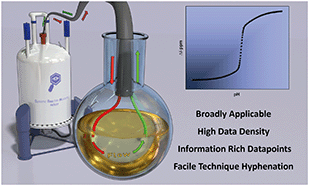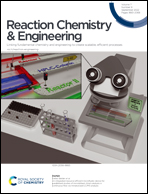Convenient and accurate insight into solution-phase equilibria from FlowNMR titrations†
Abstract
Chemical solution-phase equilibria such as acid/base reactions and complex formation are typically investigated by titration studies that either use in situ analysis of a continuously changing sample with techniques that measure single attributes (e.g. pH or UV-vis absorbance at a specific wavelength) or ex situ analysis of multiple samples with high-resolution techniques (e.g. high field NMR spectroscopy). Here we present multi-nuclear high resolution FlowNMR spectroscopy as an effective technique for the online analysis of complex solution-phase equilibria that combines the accuracy and convenience of simple in situ measurements with the high specificity and information content of high-resolution NMR spectroscopy. With a closed-loop flow setup reagent addition can be automated using a simple syringe pump and complimentary sensors (such as pH probes and UV-vis flow cells) may be added to the setup. By conducting the titration inside a glovebox connected to the FlowNMR setup even highly air- and moisture-sensitive systems may be investigated. The effectiveness of this approach is demonstrated with examples of Brønsted acid/base titrations (incl. multi-component mixtures and systems with solvent participation), hydrogen bonding interactions, Lewis acid/base interactions, and dynamic metal–ligand binding.



 Please wait while we load your content...
Please wait while we load your content...